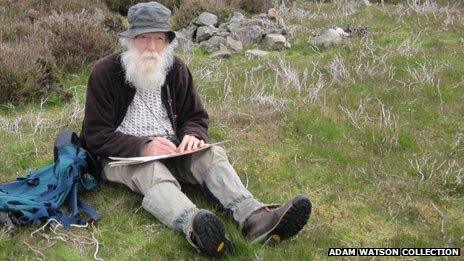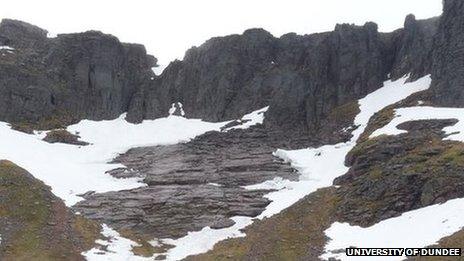Ecologist dubbed Mr Cairngorms disputes last glacier theory
- Published

Dr Adam Watson said the rocks studied were debris from avalanches
An ecologist dubbed Mr Cairngorms because of his years studying the mountains has challenged suggestions the hills had a glacier in the 1700s.
Dundee University geographer Dr Martin Kirkbride had claimed a glacier may have survived in the Cairngorms as recently as the 18th Century.
Britain's last masses of slow-moving ice and snow were understood to have melted 11,500 years ago.
But Dr Adam Watson said Dr Kirkbride had misinterpreted the geology.
Dr Kirkbride investigated rocks taken from the north facing Coire an Lochan.
Using a technique called cosmogenic 10Be dating, Dr Kirkbride showed that a small glacier in a Cairngorms corrie piled up granite boulders to form moraine ridges within the past few centuries, during the period of cool climate known as the Little Ice Age.
However, Aberdeenshire ecologist Dr Watson said the rocks were not moraine pushed up by a glacier, but a protalus rampart.
He said this was fed annually by boulders, soil, vegetation and other debris coming down in avalanches.
Dr Watson told the Mountaineering Council of Scotland that Dr Kirkbride's scientific paper was "typical of studies by geomorphologists who fail to dig a single soil pit and ignore fundamental principles of soil science".
He said others in the past had made claims of a glacier in another part of the Cairngorms, Garbh Choire Mor.
He added: "The claim in Kirkbride about moraines in Coire an Lochain of Cairn Gorm is particularly unlikely."
He said snow patches rarely survived throughout the year there, whereas in Garbh Choire Mor the patches almost always survived - making it the most likely site for a glacier in Scotland.
The ecologist was recognised for his knowledge of the Cairngorms in 2012 when he received the Fort William Mountain Festival's Scottish Award for Excellence in Mountain Culture.
Festival organisers described him as Mr Cairngorms because of his many years studying the area's landscape and wildlife.

The new research suggests glaciers survived in the Cairngorms long after they were thought to have melted
Responding to the criticism, Dr Kirkbride said: "I don't have Adam's experience of the Cairngorms - I doubt anybody does.
"But I have been visiting the Cairngorms for over 30 years, in all seasons, and I share his appreciation of the role of avalanches in modifying the landscape.
"Before writing our paper, we carefully considered several possible explanations for the boulder ridges before interpreting them, on the balance of a variety of evidence, as glacial moraines."
He said the glacier in Coire an Lochain deposited boulder ridges in a different place from where avalanches do.
Dr Kirkbride said: "In fact, it's snow avalanches in springtime which are gradually destroying the glacial moraines at the present day by eroding debris from them, not creating them.
"The ridges themselves are in the wrong orientation with respect to the cliff above to have been deposited by snow avalanches, as we explain in our paper."
- Published21 January 2014
- Published21 January 2014
- Published16 April 2013
- Published10 February 2012
- Published20 August 2010